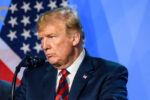President Donald Trump initiated a series of criticisms against various media personalities and organizations this week, focusing on individuals from ABC News to Time magazine in public declarations that underscored his persistent friction with the press.
The president’s sharpest critique occurred on Tuesday, October 14, 2025, when he targeted Alyssa Farah, a former White House Communications Director now co-host of ABC’s “The View,” for not fulfilling a televised promise. While speaking to reporters, Trump referred to Farah as “a joke” and described “The View” as “a fraud” because she did not wear a MAGA hat despite her January promise to do so if he achieved a Gaza peace deal.
Trump mentioned Farah’s televised pledge to wear a MAGA hat if he successfully secured the release of Israeli prisoners, a promise linked to the recent Gaza ceasefire agreement. He asserted that Farah likely never anticipated having to honor her promise and insinuated that her critical view of him shifted after receiving employment and compensation from ABC.
Additionally, Trump claimed that Farah had previously sent him what he characterized as the most beautiful letter, praising his first-term presidency and calling him a great president. He concluded by stating that he has been described as the greatest president of them all, a compliment he regarded as surpassing anything Farah had offered.
Trump’s media criticisms extended to print media as well. In a 1:30 a.m. post on his social media platform on Tuesday, he criticized Time magazine for what he labeled a “super bad” cover photo, calling it “the worst of all time.”
He specifically took issue with the upward angle of the photograph, which produced an unusual lighting effect on his head. Trump complained that editors had made his hair seem to vanish, creating the appearance of a floating crown. He questioned whether the magazine had a hidden agenda in choosing such an unflattering angle and speculated about their motives.
The Time cover accompanied an article titled “How the Trump Administration Sealed the Gaza Ceasefire Deal,” which he reluctantly acknowledged as relatively favorable coverage of his diplomatic accomplishment. The story commended Trump for brokering the deal that led to the release of Israeli hostages and established a ceasefire in Gaza, describing it as potentially a key achievement and strategic turning point for the Middle East.
Trump’s critique of Time followed his return overnight from his Middle East trip, where he celebrated the release of 20 Israeli hostages, delivered an address to the Israeli parliament, and engaged with global leaders at a summit aimed at advancing ceasefire terms and Gaza reconstruction efforts.
The president’s confrontational stance towards media criticism extended to his administration’s responses to political adversaries. On Tuesday, October 14, the White House reacted sharply to Minnesota Governor Tim Walz’s critique of Trump’s trade policies during a Democratic National Committee press call.
White House spokesperson Kush Desai dismissed Walz as an “imbecilic buffoon” after the governor criticized Trump’s tariffs on China during the press call. Walz argued that Trump’s trade war was negatively impacting American farmers and jeopardizing family farms by causing China to stop purchasing American soybeans and switch to suppliers like Brazil and Argentina.
The governor specifically criticized Trump for prioritizing what he termed a ridiculous trade war over the interests of American farmers. Walz emphasized that China had signed long-term contracts with other countries, making it challenging for American farmers to reclaim those markets. He stressed that building these trading relationships had taken decades and that recovery would take additional years.
Desai defended the administration’s strategies, asserting that Trump’s trade and tariff policies were resetting decades of “America Last” free trade policies that had harmed American industry and communities. He argued that these policies addressed how American farmers had been unfairly excluded from foreign markets.
Trump’s media confrontations have also attracted criticism from editorial boards, with The Wall Street Journal publishing an editorial titled “Donald Trump and Letitia James, Lawfare Pals” that criticized both the president and New York Attorney General Letitia James for their mutual legal conflicts. The editorial described their ongoing legal disputes as “madness” and cautioned against what it termed “mutual assured legal destruction.”
These recent events continue Trump’s pattern of openly challenging media coverage and political opponents through public statements and social media posts, maintaining the combative approach toward press relations that characterized his first term.








